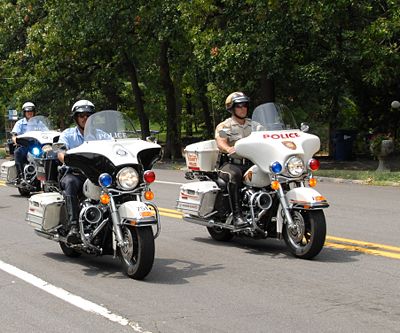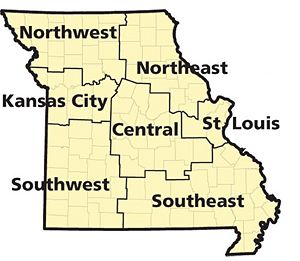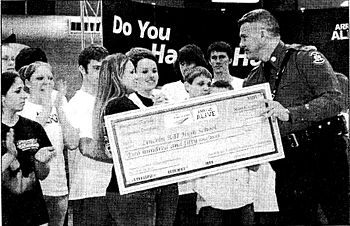616.16 Law Enforcement Services

The use of law enforcement, both active and passive, is an effective tool to ensure traffic complies with work zone requirements arising from certain construction projects and maintenance operations. The use of law enforcement will vary from project to project and the core team decides whether to use these services. If law enforcement is selected, the core team must determine early within the scoping process the type of enforcement that will provide the greatest benefit to the safety of the work zone, the location within the work area where enforcement is intended to occur, and the schedule of when it can best be used to compliment the traffic control plan. These details should be included in the traffic control plan and discussed with law enforcement as described in the job special provisions. The Law Enforcement in the Work Zone JSP shall be included when law enforcement is being considered.
616.16.1 Guidelines for Providing Law Enforcement Services
The following are recommended procedures to provide law enforcement in MoDOT construction zones.
A. Funds for work zone enforcement come from the district’s allocation of safety funds (HSIP) and are included in the STIP.
B. Each district is to forecast the number of enforcement hours needed and the designated routes scheduled for the year’s construction projects. The average hourly rate for law enforcement is approximately $75.00 per hour.
C. Each district is to set up and include in the STIP their funding levels for the work zone enforcement activities needed.
D. The district submits the planned estimates and designated roadways or projects/operations to the Highway Safety section for review. The estimated needs for enforcement in a given fiscal year should be provided no later than April 1 to ensure contracts are set up prior to the fiscal year. The Highway Safety section will contact law enforcement agencies to discuss schedule scope and the requested enforcement activity logistics. This will provide the first opportunity to communicate the desired type and level of enforcement. The law agencies should be contacted at least three months prior to the start of the fiscal year.
E. The Highway Safety section will work up the appropriate contract agreements and send these to the selected law enforcement agencies. Contracts should be executed prior to the start of any enforcement activities.

F. A pre-construction meeting will be held with the district, construction companies and law enforcement agencies to finalize project time, schedule, scope and logistics. The pre-construction meeting will be used to communicate the details of the traffic control plan and how law enforcement activities can best compliment this plan. These details include the type of enforcement that will provide the greatest benefit to the safety of the work zone, the location within the work area where the enforcement is intended to occur, and the schedule of enforcement. This meeting should take place 2 to 3 months prior to the actual work being conducted to allow law enforcement agencies to prepare officer work schedules.
G. Districts will work directly with law enforcement agencies to ensure proper enforcement coverage in designated work zones.
H. Enforcement activity billing will be sent to the district for review and approval. Once approved, the district will submit the invoice to the Highway Safety section for payment. All activity will be tracked and a detailed report of expenditures and enforcement activity will be provided to appropriate personnel.
616.16.2 Guidelines for the Selection of Law Enforcement Services
To foster the continued use of and streamline the process for securing this service, MoDOT district staff will identify those projects or operations that can benefit from such support and estimate the number of service hours needed for each project or operation identified. This information will then be used to establish a project number with associated funding for the reimbursement of law enforcement services to be provided in each district and assist the Highway Safety section in securing those services for the districts. Consider law enforcement for:
- Types of Facilities
- Freeway
- Expressway
- Multilane with shoulders
- Speeds
- Normal posted speed greater than or equal to 55 mph
- Operating speeds greater than speed limit
- Traffic Control
- Lane closure
- Moving operation in lane

When discussing the possibility of using law enforcement services, the core team should also consider:
- Past experience in an area or with a type of work
- Availability of law enforcement
- Complexity or impact of a project/operation
- Output from MoDOT’s Transportation Management Strategy Matrix
- Whether there is a propensity for traffic back-ups
- Whether law enforcement would aid a project performed as night work
There is no pay item for law enforcement services.
Law Enforcement In the Work Zone Job Special Provision
616.16.3 Guidelines for the Use of Law Enforcement Services
Providing advance warning for the work zone or queues that may have formed are critical to a safe work zone and having the same priorities for all parties involved is important to achieve this goal. To minimize high-risk situations, law enforcement services can be used and the goals and priorities of using these services are:
- Work Zone Awareness
- Minimize Queue
- Queue Protection (Minimize High-Speed Rear-End Crashes)
- Quality Traffic Control
| Handout |
| The goals and priorities and placement of law enforcement are presented in MoDOT’s Strategy for Law Enforcement in Work Zones. |
- Speed Enforcement.
Where the law enforcement officer is placed is critical to achieving these goals. When no queue is present, the law enforcement officer should be located safely on the shoulder between a ¼ mile and ½ mile upstream of the lane drop. When a queue is present, the law enforcement officer should be a ¼ mile upstream of the queue at all times, meaning, if the queue grows, the law enforcement officer should also move back with the queue. However, if the presence of the law enforcement officer is creating a queue or worse conditions, the officer should relocate downstream of the work zone or be considered for removal.